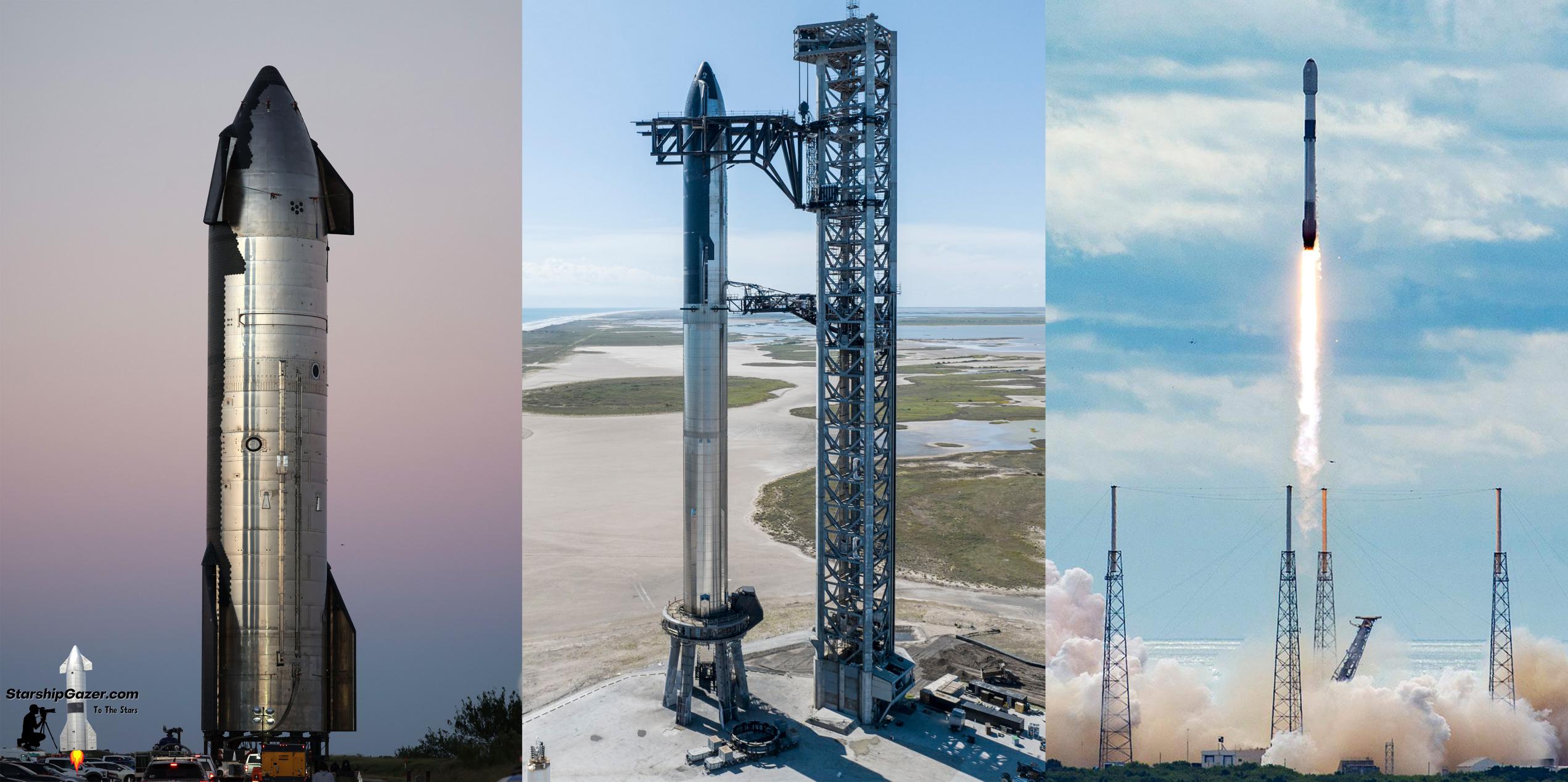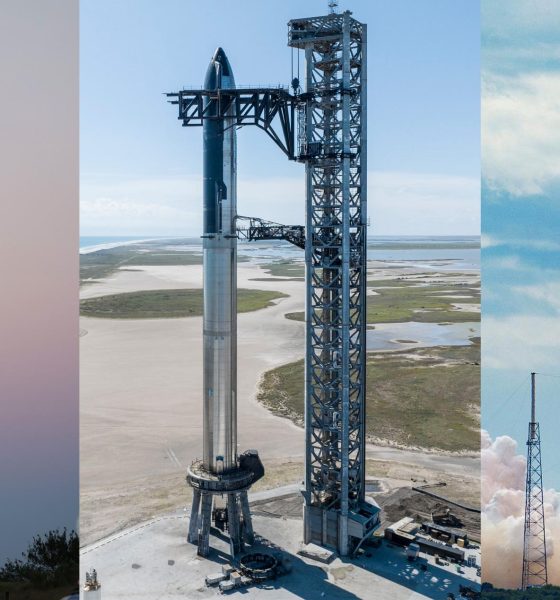

News
SpaceX rolls out Starship, stacks world’s largest rocket, and aces Starlink launch hours apart
In 15 hours, SpaceX has rolled a new Starship to its South Texas launch and test facilities, reassembled the world’s largest rocket, launched Starlink satellites to orbit, and recovered a reused Falcon 9 booster in port.
The burst of activity began around sunset at SpaceX’s Starbase rocket factory in Boca Chica, Texas when a new orbital-class Starship prototype left its ‘nest’ for the first time. SpaceX rolled the Starship – known as Ship 25 – a few miles down the highway to its nearby launch and test facilities, where workers connected it to a large crane and waited for daylight.
Around 9 am CDT the following day, October 20th, SpaceX lifted Ship 25 onto one of two Starship test stands, where it will eventually attempt to complete several qualification tests. While Ship 25 was still suspended in mid-air, the Starbase launch pad’s orbital launch tower began lifting a different prototype, Ship 24, into the air with a pair of giant ‘chopsticks’ – mechanical arms designed by SpaceX to replace one of the largest mobile cranes in the world.
Then, while it was stacking Ship 24 on top of Super Heavy Booster 7 and installing Ship 25 on a test stand, a Falcon 9 rocket carrying 54 new Starlink satellites lifted off from Cape Canaveral, Florida. Minutes prior, SpaceX finished craning a reused Falcon 9 booster off one of its drone ship landing platforms in a port ten miles south.
Starlink 4-36 was SpaceX’s 48th launch of 2022 and 56th launch in less than 12 months, so its Falcon launch program simply doesn’t have time to waste. Drone ship Just Read The Instructions (JRTI) returned to port with Falcon 9 booster B1069 about 12 hours before the rocket was transferred from the ship’s deck to a stand on SpaceX’s Port Canaveral dock space. The company will now be able to retract B1069’s legs and complete any necessary booster and drone ship refurbishment, ensuring that both will be ready for their next missions in the near future.
Back in Texas, SpaceX is scheduled to begin thoroughly testing a fully-stacked Starship rocket for the first time as early as Monday, October 24th. Ship 24 was reinstalled on Booster 7 for that purpose after SpaceX disassembled the pair for several days, possibly due to forecasts of high winds. The test campaign is expected to begin with the first full wet dress rehearsal (WDR) of a two-stage Starship, meaning that the rocket will be fully loaded with thousands of tons of liquid methane and oxygen propellant and run through a simulated launch countdown that ends just before engine ignition.
If successful, SpaceX will likely restart Booster 7 static fire testing and continue to work its way up to the first simultaneous ignition of all 33 of its Raptor 2 engines. If the pair survive WDR and static fire testing, SpaceX could begin preparing the same rocket for Starship’s orbital launch debut.
If significant issues arise during testing, SpaceX could choose to retire Ship 24 and/or Booster 7 and move on to a new and improved pair: likely Ship 25 and Booster 8 or 9. Already complete, Super Heavy Booster 8 has been sitting untouched at Starbase’s launch site for weeks, making it uncertain whether SpaceX actually intends to test or use the prototype. Booster 9 is just one stack away from completion, at which point it will be ready to begin proof testing. According to CEO Elon Musk, B9 features significant improvements that will make it more resilient to mid-flight Raptor engine failures. It could also be the first Super Heavy booster with no hydraulic system, thanks to a new version of Raptor that replaces hydraulic thrust vectoring with a battery-powered alternative.
Starship S25 could kick off its own proof testing as early as next week. Unlike Ship 24, Ship 25 went straight from the factory to a test stand that has been modified with six hydraulic rams. Those rams will simulate the thrust of six Raptor 2 engines (up to ~1400 tons or 3.1M lbf) while the Starship is simultaneously loaded with cryogenic liquid oxygen and/or nitrogen, combining peak mechanical and thermal stresses into one test. Once Ship 25 is done, it will be rolled back to the factory for Raptor engine installation and will eventually return to the pad for static fire testing.

News
Tesla FSD fleet is nearing 7 billion total miles, including 2.5 billion city miles
As can be seen on Tesla’s official FSD webpage, vehicles equipped with the system have now navigated over 6.99 billion miles.

Tesla’s Full Self-Driving (Supervised) fleet is closing in on almost 7 billion total miles driven, as per data posted by the company on its official FSD webpage.
These figures hint at the massive scale of data fueling Tesla’s rapid FSD improvements, which have been quite notable as of late.
FSD mileage milestones
As can be seen on Tesla’s official FSD webpage, vehicles equipped with the system have now navigated over 6.99 billion miles. Tesla owner and avid FSD tester Whole Mars Catalog also shared a screenshot indicating that from the nearly 7 billion miles traveled by the FSD fleet, more than 2.5 billion miles were driven inside cities.
City miles are particularly valuable for complex urban scenarios like unprotected turns, pedestrian interactions, and traffic lights. This is also the difference-maker for FSD, as only complex solutions, such as Waymo’s self-driving taxis, operate similarly on inner-city streets. And even then, incidents such as the San Francisco blackouts have proven challenging for sensor-rich vehicles like Waymos.
Tesla’s data edge
Tesla has a number of advantages in the autonomous vehicle sector, one of which is the size of its fleet and the number of vehicles training FSD on real-world roads. Tesla’s nearly 7 billion FSD miles then allow the company to roll out updates that make its vehicles behave like they are being driven by experienced drivers, even if they are operating on their own.
So notable are Tesla’s improvements to FSD that NVIDIA Director of Robotics Jim Fan, after experiencing FSD v14, noted that the system is the first AI that passes what he described as a “Physical Turing Test.”
“Despite knowing exactly how robot learning works, I still find it magical watching the steering wheel turn by itself. First it feels surreal, next it becomes routine. Then, like the smartphone, taking it away actively hurts. This is how humanity gets rewired and glued to god-like technologies,” Fan wrote in a post on X.
News
Tesla starts showing how FSD will change lives in Europe
Local officials tested the system on narrow country roads and were impressed by FSD’s smooth, human-like driving, with some calling the service a game-changer for everyday life in areas that are far from urban centers.

Tesla has launched Europe’s first public shuttle service using Full Self-Driving (Supervised) in the rural Eifelkreis Bitburg-Prüm region of Germany, demonstrating how the technology can restore independence and mobility for people who struggle with limited transport options.
Local officials tested the system on narrow country roads and were impressed by FSD’s smooth, human-like driving, with some calling the service a game-changer for everyday life in areas that are far from urban centers.
Officials see real impact on rural residents
Arzfeld Mayor Johannes Kuhl and District Administrator Andreas Kruppert personally tested the Tesla shuttle service. This allowed them to see just how well FSD navigated winding lanes and rural roads confidently. Kruppert said, “Autonomous driving sounds like science fiction to many, but we simply see here that it works totally well in rural regions too.” Kuhl, for his part, also noted that FSD “feels like a very experienced driver.”
The pilot complements the area’s “Citizen Bus” program, which provides on-demand rides for elderly residents who can no longer drive themselves. Tesla Europe shared a video of a demonstration of the service, highlighting how FSD gives people their freedom back, even in places where public transport is not as prevalent.
What the Ministry for Economic Affairs and Transport says
Rhineland-Palatinate’s Minister Daniela Schmitt supported the project, praising the collaboration that made this “first of its kind in Europe” possible. As per the ministry, the rural rollout for the service shows FSD’s potential beyond major cities, and it delivers tangible benefits like grocery runs, doctor visits, and social connections for isolated residents.
“Reliable and flexible mobility is especially vital in rural areas. With the launch of a shuttle service using self-driving vehicles (FSD supervised) by Tesla in the Eifelkreis Bitburg-Prüm, an innovative pilot project is now getting underway that complements local community bus services. It is the first project of its kind in Europe.
“The result is a real gain for rural mobility: greater accessibility, more flexibility and tangible benefits for everyday life. A strong signal for innovation, cooperation and future-oriented mobility beyond urban centers,” the ministry wrote in a LinkedIn post.
News
Tesla China quietly posts Robotaxi-related job listing
Tesla China is currently seeking a Low Voltage Electrical Engineer to work on circuit board design for the company’s autonomous vehicles.

Tesla has posted a new job listing in Shanghai explicitly tied to its Robotaxi program, fueling speculation that the company is preparing to launch its dedicated autonomous ride-hailing service in China.
As noted in the listing, Tesla China is currently seeking a Low Voltage Electrical Engineer to work on circuit board design for the company’s autonomous vehicles.
Robotaxi-specific role
The listing, which was shared on social media platform X by industry watcher @tslaming, suggested that Tesla China is looking to fill the role urgently. The job listing itself specifically mentions that the person hired for the role will be working on the Low Voltage Hardware team, which would design the circuit boards that would serve as the nervous system of the Robotaxi.
Key tasks for the role, as indicated in the job listing, include collaboration with PCB layout, firmware, mechanical, program management, and validation teams, among other responsibilities. The role is based in Shanghai.
China Robotaxi launch
China represents a massive potential market for robotaxis, with its dense urban centers and supportive policies in select cities. Tesla has limited permission to roll out FSD in the country, though despite this, its vehicles have been hailed as among the best in the market when it comes to autonomous features. So far, at least, it appears that China supports Tesla’s FSD and Robotaxi rollout.
This was hinted at in November, when Tesla brought the Cybercab to the 8th China International Import Expo (CIIE) in Shanghai, marking the first time that the autonomous two-seater was brought to the Asia-Pacific region. The vehicle, despite not having a release date in China, received a significant amount of interest among the event’s attendees.








